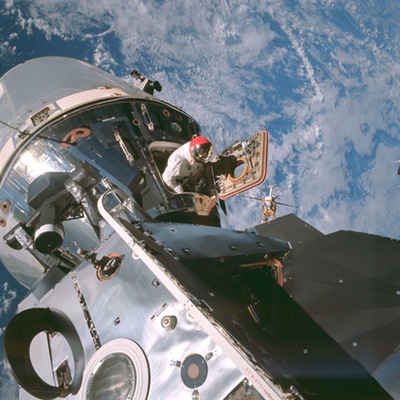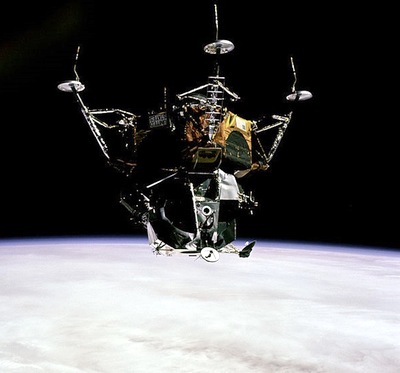Apollo 9: testing the lunar moduleby Anthony Young
|
| Essential to a prelude for a lunar landing had to be the full crewed testing of the lunar module in low Earth orbit, including the ability to rendezvous with the Command Service Module. |
The lunar module’s first flight was unmanned, aboard a specially-configured Saturn 1B for an Earth orbital mission for Apollo 5. As evidence of the problems encountered with development of the lunar module, LM-1 was not fitted with glass windows, but with aluminum plates; during a pressurization test, one of the glass windows shattered. In addition, LM-1 would be launched without its landing legs or environmental control system; LM-2 was built but never flown.
SA-204 with its LM-1 payload was launched on January 22, 1968. It was successfully inserted into a 163-by-222-kilometer Earth orbit. The first lunar module decent engine programmed burn of 39 seconds stopped prematurely after four seconds by a flight software error. Flight controllers nevertheless conducted several descent engine burns as well as the “fire in the hole” ascent engine test to simulate separation from the descent stage. Despite the anomaly of the first descent engine burn, NASA deemed the remainder of the lunar module tests so successful that the second unmanned mission was canceled.
Apollo 9 mission planning and flight hardware
Essential to a prelude for a lunar landing had to be the full crewed testing of the lunar module in low Earth orbit, including the ability to rendezvous with the Command Service Module (CSM). Mission planners had discussed the possibility of launching separate Saturn IBs, one with the lunar module and the second with the astronauts aboard a Command Module (CM) with its Service Module, and have the crew rendezvous with the LM much like the rendezvous of the Gemini 6 and 7 spacecraft. This idea was eventually tabled with the correct conclusion that an all-up Saturn V was the path to take.
When it became clear to the Manned Spacecraft Center in Houston and Kennedy Space Center in Florida that Grumman’s LM-3 would not be ready in time for Apollo 8 to conduct such a mission, Apollo 8 was reconfigured to be a lunar orbit mission without the LM, and LM-3 would be tested for Apollo 9. LM-3 arrived at KSC from Grumman in June of 1968. Inspectors found cracks in the ascent engine stage, and it replaced with a heavier engine. LM-3 began a series of tests in the Manned Spacecraft Operations Building (MSOB). Two tests took place in the altitude chamber with the prime crew and two tests with the backup crew in September. Many other tests of the LM also occurred prior to the manned tests.
The first, second, and third stages of AS-504 were assembled on the mobile launch platform by the fall of 1968. The CSM for Apollo 9 arrived at KSC in October and NASA conducted docking tests between the CSM and LM-3. In December, workers secured LM-3 to the spacecraft lunar module adapter (SLA) via the four LM-Adapter attachment points of the folded landing gear. It would have a launch weight of 14,508 kilograms. The four sections of the SLA were closed and then the CSM was mated to the SLA. Finally, the Launch Escape System was mated to the CM. The crawler transporter moved the entire space vehicle to launch complex pad 39-A on January 3. Nearly two further months of tests of the entire launch vehicle and spacecraft took place prior to the intended February 28 launch.
Apollo 9 Crew and Training
NASA selected the crew for the Apollo 9 mission more than two years before. Two of the three astronauts were Gemini veterans. The Apollo 9 Commander was James McDivitt, who flew on Gemini 4; Command Module Pilot David Scott was on Gemini 8. Lunar Module Pilot Russell Schweickart was going into space for the first time.
| McDivitt, Scott, and Schweickart’s third day in orbit was filled with ambitious Apollo-era firsts. |
McDivitt graduated first in his class in 1959 from the University of Michigan with a bachelor of science degree in aeronautical engineering. He had flown 145 combat missions during the Korean War and held the Air Force rank of colonel. Scott graduated fifth in his class at West Point and later received his master of science degree from MIT. He served four years overseas, became a test pilot on his return to America, and was selected by NASA in 1963. He also held the rank of colonel. Schweickart earned bachelor and master of science degrees from MIT. He had more than 2,000 hours flight time in jets. He was among the third group of astronauts selected by NASA in October 1963.
The Apollo 9 astronauts spent more than seven hours in training for every hour of the scheduled ten-day mission. The three main training environments were one-G command and lunar module mockup training, zero-G flight parabola and water immersion training, and altitude chamber testing. Schweickart also trained using the extravehicular mobility unit he would use during his spacewalk, during which he was expected to transfer from the LM to the CM.
 Astronaut Dave Scott stands in the open hatch of the command module during the Apollo 9 mission. (credit: NASA) |
Launch day and orbit
On February 26, news media reported that all three crewmembers had sore throats and colds. NASA rescheduled the launch date to March 3. The flight surgeon cleared the crew that day and, after breakfast, they suited up and were taken to the Saturn V, strapped into their couches and awaited the 11:00 am launch. There were no delays in the countdown and they lifted off on time. The S-IVB third stage put them in a nearly circular 102.3-by-103.9-kilometer orbit.
Just two hours and 43 minutes into the mission, Scott triggered the pyrotechnics to separate the CSM from the SLA, which then released the four panels to reveal the lunar module they had named Spider. Scott initiated the transposition and docking maneuver, carefully docking with the LM. The LM was released from the S-IVB and Scott fired the service module thrusters to pull Spider away from the third stage, which shortly thereafter was sent into a solar orbit trajectory.
The first docked SPS engine firing took place about six hours into the mission and lasted only five seconds. This was to check the integrity of the spacecraft interface and what, if any, effect the mass of the LM would have on the CM. There were no anomalies. The remainder of their first day in space was spent eating, resting, and going over the checklist for their second day before going to sleep.
On the second day, the crew performed three SPS maneuvers that included gimbaling of the engine to check the spacecraft’s guidance and navigation autopilot performance. The first such burn lasted 110 seconds. The next firing of the SPS engine lasted 280 seconds and raised the spacecraft’s orbit from 357 to 509 kilometers for better ground tracking and lighting conditions during the rendezvous maneuver. There was a third SPS firing lasting 28 seconds.
McDivitt, Scott, and Schweickart’s third day was filled with ambitious Apollo-era firsts. Scott removed the CM hatch between the two spacecraft, then the CM docking probe and LM droge from the tunnel so Schweickart and McDivitt would have access to Spider. The two astronauts in the LM closed their hatch and Scott did the same in the CM. Schweickart took relish in deploying the LM’s landing gear. All astronauts donned their EVA suits and McDivitt helped Schweickart secure the personal life support system (PLSS). McDivitt and Scott attached umbilicals to their suits, and both spacecraft were depressurized.
| Apollo 9 brought NASA one step closer to achieving the goal of landing humans on the Moon by the end of the decade. |
Schweickart exited the LM through its hatch at roughly 73 hours into the mission. This would be the first and only test of PLSS in space prior to Apollo 11. Scott opened the CM hatch and positioned himself in the opening to photograph Schweickart. Scott also conducted an EVA to retrieve thermal samples from the exterior of the CM and SM exterior. Schweickart retrieved thermal samples from the exterior of the LM, returned to the “porch” of the LM immediately in front of the egress hatch, and secured himself into boot restraints so he was free to take photographs. The PLSS also housed the communications equipment, which worked without any problems.
Day 5 and rendezvous with Spider
On the fifth day of the mission, March 7th, the planned spacecraft separation and rendezvous was performed. With McDivitt and Schweickart in the LM and Scott in the CM, separation of the two spacecraft took place at 92 hours, 39 minutes, and 16 seconds. The lunar module descent engine was used for the phasing and orbital insertion maneuvers. Schweickart placed the LM roughly 120 kilometers from the CM.
Staging of the descent and ascent stages was, according to McDivitt, “…sort of a kick in the fanny…but it went alright.” The astronauts initiated the rendezvous maneuver and it took about an hour before Spider was within 30 meters of the CM. The many hours of training paid off handsomely and the two spacecraft successfully docked at 99 hours into the mission. There were many happy faces at Grumman and NASA.
McDivitt and Schweickart transferred to the CM, closing out the LM and Scott reinstalled the CM hatch. The two spacecraft separated three hours later, and the LM ascent stage was later fired for 362.4 seconds to propellant depletion to place it into an exaggerated elliptical orbit.
Apollo 9 enters the history books
The remainder of the mission was devoted to further SPS engine firings, tracking exercises, photography, experiments and other duties. On the tenth and last day of their mission, Scott performed the last SPS engine burn to initiate their return to Earth, and then separated from the service module. The command module Gumdrop splashed down in the Atlantic Ocean northeast of Puerto Rico. The traditional cigars marking the successful end of the mission were handed out at launch control at Kennedy Space Center and Mission Control in Houston. Apollo 9 brought NASA one step closer to achieving the goal of landing humans on the Moon by the end of the decade. Apollo 10 would next test the LM in a near identical mission profile to a lunar landing. It would be the final rehearsal.
